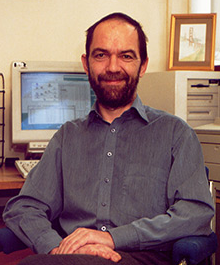Archival Notice
This is an archive page that is no longer being updated. It may contain outdated information and links may no longer function as originally intended.
Home | Glossary | Resources | Help | Contact Us | Course Map
DNA typing was introduced into forensic science in the mid-1980s, arising from discoveries made in biomedical research. Ray White, an American geneticist at the University of Utah, identified regions of DNA that did not code for proteins but were highly variable between individuals.
Early research included the use of restriction enzymes to cut strands of DNA at specific locations and produce DNA fragments of defined lengths. White separated the fragments based on size, calling the variations restriction fragment length polymorphisms (RFLP). In 1980, White and colleagues described the first polymorphic RFLP marker and proposed methods for mapping the human genome based on RFLP technology.01
The first forensic science applications of the technique arose from the work of Alec Jeffreys who found that RFLP technology could be used to develop patterns of restricted DNA that were more or less specific to an individual. At the time, his work focused on paternity testing. In 1985, the British police from West Midlands approached Jeffreys to assist them in a rape-homicide case. Jeffrey's work resulted in the release of a wrongfully convicted man and the apprehension and conviction of the true perpetrator. Soon thereafter, RFLP DNA evidence contributed to the convictions of Tommy Lee Andrews in Florida and Timothy Wilson Spencer in Virginia.02
The pieces of DNA cut by the restriction enzymes contain genes and non-coding DNA. The non-coding DNA includes regions consisting of direct repeats of the same sequence of bases, referred to as tandem repeats. The number of repeats of the sequence is genetically determined and, provided that the sequence is long enough and is repeated a sufficient number of times, will affect the length of the restriction fragment. These regions are called variable number of tandem repeats (VNTR) loci.
Additional Online Courses
- What Every First Responding Officer Should Know About DNA Evidence
- Collecting DNA Evidence at Property Crime Scenes
- DNA – A Prosecutor’s Practice Notebook
- Crime Scene and DNA Basics
- Laboratory Safety Programs
- DNA Amplification
- Population Genetics and Statistics
- Non-STR DNA Markers: SNPs, Y-STRs, LCN and mtDNA
- Firearms Examiner Training
- Forensic DNA Education for Law Enforcement Decisionmakers
- What Every Investigator and Evidence Technician Should Know About DNA Evidence
- Principles of Forensic DNA for Officers of the Court
- Law 101: Legal Guide for the Forensic Expert
- Laboratory Orientation and Testing of Body Fluids and Tissues
- DNA Extraction and Quantitation
- STR Data Analysis and Interpretation
- Communication Skills, Report Writing, and Courtroom Testimony
- Español for Law Enforcement
- Amplified DNA Product Separation for Forensic Analysts


